Team:Heidelberg
From 2009.igem.org
| Line 13: | Line 13: | ||
{| class="wikitable" cellpadding="8" | {| class="wikitable" cellpadding="8" | ||
| - | |-valign="top" width=" | + | |-valign="top" width="150px" bgcolor="#CCC" |
|style="border:3px solid #FFF;"| | |style="border:3px solid #FFF;"| | ||
| - | [[Image:HD09_IGEM_Team.png|center| | + | [[Image:HD09_IGEM_Team.png|center|150 px|border|Team]] |
'''Team''' <br> | '''Team''' <br> | ||
Thirteen students and eleven advisors are working on this four month project. We split up into several subgroups whos focus and results you can follow on the Notebook and Results page. If you want to know more about the subgroups and the people involved, meet us on our Team page and let's get to know each other better at the Jamboree in Boston. | Thirteen students and eleven advisors are working on this four month project. We split up into several subgroups whos focus and results you can follow on the Notebook and Results page. If you want to know more about the subgroups and the people involved, meet us on our Team page and let's get to know each other better at the Jamboree in Boston. | ||
| Line 28: | Line 28: | ||
As one of the most important approaches to synthezise synthetic promotors we developed a database that predicts the position of conserved promotor binding sequences. We identified conserved sequences ourselves, analyzed the data and coded an easy to use interface that ise available for public use. | As one of the most important approaches to synthezise synthetic promotors we developed a database that predicts the position of conserved promotor binding sequences. We identified conserved sequences ourselves, analyzed the data and coded an easy to use interface that ise available for public use. | ||
[http://igem.bioquant.uni-heidelberg.de/mediawiki/index.php/Modeling Please read more] | [http://igem.bioquant.uni-heidelberg.de/mediawiki/index.php/Modeling Please read more] | ||
| - | |-valign="top" width=" | + | |-valign="top" width="150px" bgcolor="#CCC" |
|style="border:3px solid #FFF;"| | |style="border:3px solid #FFF;"| | ||
| - | [[Image:HD09_Notebook_klein3.png|center| | + | [[Image:HD09_Notebook_klein3.png|center|150px|Notebook]] |
'''Notebook''' <br> | '''Notebook''' <br> | ||
What's about documenation? You will find the entire progress of the project and all the important steps on our Notebook page. The Notebook is divided into the individual subgroups. | What's about documenation? You will find the entire progress of the project and all the important steps on our Notebook page. The Notebook is divided into the individual subgroups. | ||
| Line 44: | Line 44: | ||
[http://igem.bioquant.uni-heidelberg.de/mediawiki/index.php/Modeling Please read more] | [http://igem.bioquant.uni-heidelberg.de/mediawiki/index.php/Modeling Please read more] | ||
| - | |-valign="top" width=" | + | |-valign="top" width="150px" bgcolor="#CCC" |
|style="border:3px solid #FFF;"| | |style="border:3px solid #FFF;"| | ||
'''Gallery'''<br> | '''Gallery'''<br> | ||
Revision as of 10:03, 8 October 2009
iGem Heidelberg Mission 2009: SpybricksEstablishing new standards for iGEM, the Heidelberg 2009 team will be concerned with developing ways for measuring promoters in mammalian cells, a default chassis and a first evaluation of the recently postulated BioBrick beta proposal 2 (Tom Knight). Considering the importance of controlling gene expression, our team's work will focus on natural and synthetic mammalian promoters. Our vision is to provide the synthetic biology community with a methodical library of such promoters (with different output strength and sensitivity to different regulatory proteins) and a model which can provide guidance for the development of further synthetic promoters. Our efforts will therefore, from the very beginning, equally entail bioinformatics and wet lab work.
|
Our TeamThis year 13 students are part of the [http://igem.bioquant.uni-heidelberg.de/mediawiki/index.php/Team Heidelberg iGEM Team.]
NewsThis is the latest news! Sep 2009, iGEM Team Heidelberg wins Gold Medal
http://igem.bioquant.uni-heidelberg.de/mediawiki/index.php/News See more |
 "
"
